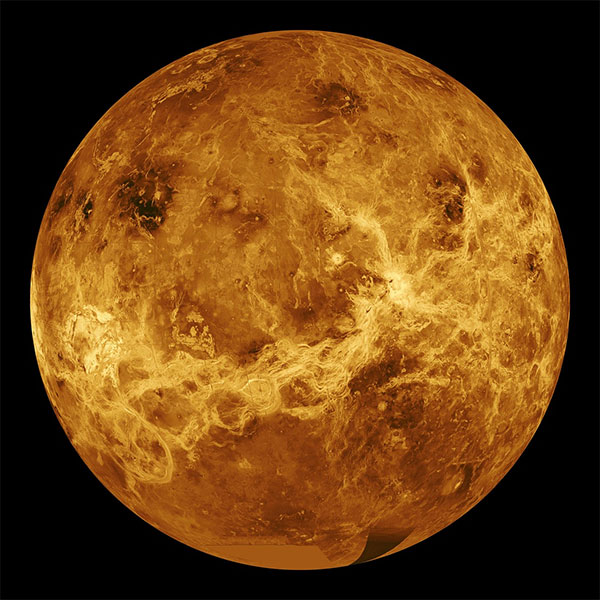Overview of Venus
Venus or Venus is the second planet in the Solar System, revolving around it with a cycle of 224.7 Earth days.
Venus is classified as a terrestrial planet and sometimes it is considered a "sister planet" with Earth due to its size, attractive acceleration, orbital parameters similar to Earth. However, it has been shown that it is very different from Earth on other sides.
Venus is surrounded by highly reflective thick clouds containing sulfuric acid, and makes it impossible to observe its surface under visible light wavelengths.
Venus's diameter is 12,092km (less than 650km of Earth) and its mass is 81.5% of Earth's mass. Geomorphology on the surface of the planet is far different from the topography on Earth, because the planet has a very thick carbon dioxide atmosphere. The total mass of carbon dioxide accounts for 96.5% of the atmospheric mass, and the majority of the remaining mass is 3.5% of nitrogen.

Venus is captured by the Magellan spacecraft 2012.
The structure of Venus
The proximity to specific diameters and masses between Venus and the Earth suggests that they have similar internal structure: planetary core, coating, and shell. Like Earth, the Venusian core is at least partially liquid because the two planets have cold processes / internal heat dissipation with the same speed.
The smaller diameter of Venus shows that the parts deep inside the planet suffer from smaller pressures than Earth's. The main difference between the two planets is that scientists do not have evidence of plate tectonic activity on Venus, probably because the shell is too hard to sink into the continental plate, without have liquid water so they can slip on each other.
Geology on Venus
The geomorphology of Venus shows up with the impact of volcanic activity. Scientists calculate the surface of Venus with the age of 300–600 million years.
There are about 1,000 impact craters distributed throughout the Venusian surface. On other celestial bodies such as Earth or Moon, collisions show their disappearance. On Venus, about 85% of collisions are still in their original state.
The atmosphere and climate of Venus
Venus has a very thick atmosphere, containing mainly CO2 and a small amount of N2. The atmospheric mass of this planet is 93 times greater than the mass of Earth's atmosphere, while the surface pressure is 92 times higher than that of the Earth - this is equivalent to a depth of almost 1 = km from the ocean surface on Earth.

Venus atmosphere shot in 1979 through ultraviolet wavelengths from the Pioneer Venus Orbiter.
Above the concentrated CO 2 atmosphere are clouds containing mainly SO 2 and sulfuric acid droplets. The winds in Venus's atmosphere are about 60 times the speed of the planet's rotation, while the strongest winds on Earth have a speed of only 10% to 20% of the rotation speed of it.
Magnetic field on Venus
Venus's magnetic field is much weaker than Earth's.
Scientists say there is a possibility that Venus does not have a hard core inside. or at present its core is no longer dissipating heat, so the entire rotating liquid body has approximately the same temperature.
Venus's trajectory
Venus's orbit around the Sun has an average distance of 0.72 AU (108 million km; 67 million mi), and completes an orbit of about 224.65 days. Although every planet has an elliptical orbit, Venus's orbits have the closest circular form, with orbital eccentricities smaller than 0.01.
The explorer ship Venus
The first robotic space mission to Venus and also the first planet of a human ship to explore, began on 12 February 1961, with the Venera 1 being launched.
The US Venus exploratory program also started with the failure of the Mariner one during launch. The Mariner 2 was more successful when it survived 109 days after its orbit and on December 14, 1962 it became the first successful planetary exploration mission, reaching Venus at a distance of 34,833. kilometer.
- Venus can stay?
- NASA wants to bring people to Venus
- Venus Experss are about to plunge into the Venusian atmosphere
- Venus is about to be a
- After 8 years of Venus exploration, Venus Express has run out of fuel
- 10 most interesting things about Venus
- Plan to conquer human Venus
- The ocean may exist on Venus on Earth about 700 million years ago
- Video: Unusual midnight in hell Venus
- Venus has volcanic eruptions
- Century astronomical banquet: Venus passes through the Sun.
- Science explains why Venus has so few volcanoes
 Van Allen's belt and evidence that the Apollo 11 mission to the Moon was myth
Van Allen's belt and evidence that the Apollo 11 mission to the Moon was myth The levels of civilization in the universe (Kardashev scale)
The levels of civilization in the universe (Kardashev scale) Today Mars, the sun and the Earth are aligned
Today Mars, the sun and the Earth are aligned The Amazon owner announced a secret plan to build a space base for thousands of people
The Amazon owner announced a secret plan to build a space base for thousands of people